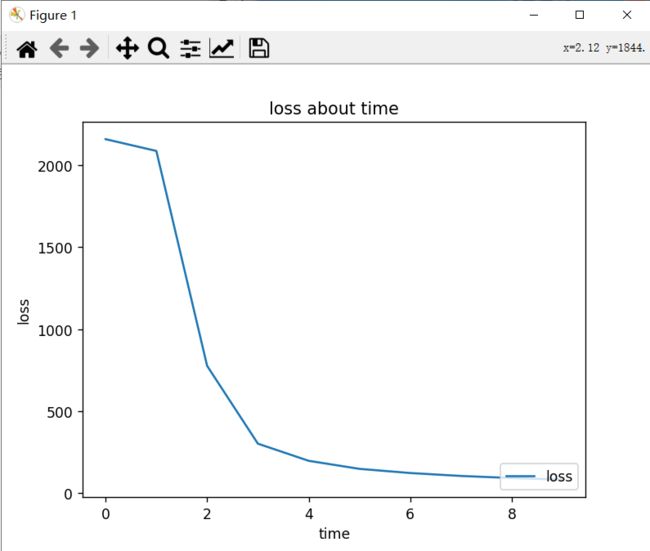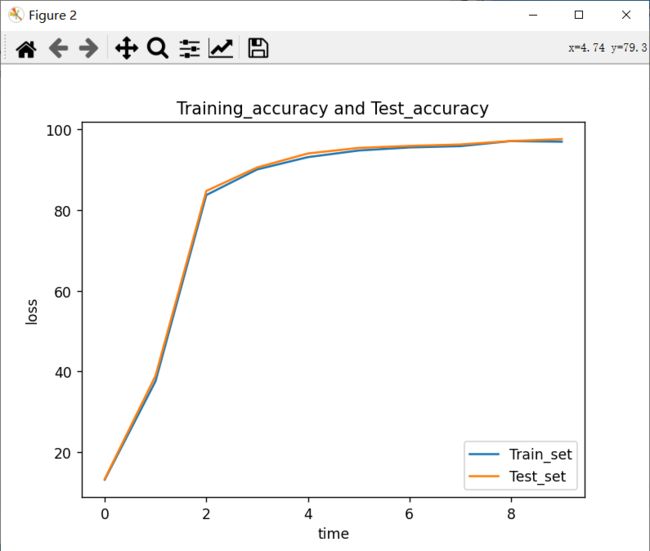python 使用简易残差神经网络处理手写数字识别数据集
残差网络模型
残差网络(Residual Network,ResNet)是在神经网络模型中给非线性层增加直连边的方式来缓解梯度消失问题,从而使训练深度神经网络变得更加容易
# 使用了六个模块 # 1)模块一: 包含一个步长为2、大小为7×7的卷积层, 卷积层的输出通道数为64, 卷积层的输出经过批量规范化、ReLU激活函数的处理后, 接了一个大小为3×3的最大汇聚层. # 2)模块二: 包含两个残差单元, 输入通道数为64, 输出通道数为64, 特征图大小保持不变 # 3)模块三: 包含两个残差单元, 输人通道数为64, 输出通道数为128, 特征图大小缩小一半 # 4)模块四: 包含两个残差单元, 输人通道数为128, 输出通道数为256, 特征图大小缩小一半 # 5)模块五: 包含两个残差单元, 输入通道数为256, 输出通道数为512, 特征图大小缩小一半 # 6)模块六: 包含一个全局平均汇聚层, 将特征图大小变为1×1, 最终经过全连接层计算出最后的输出.
代码如下:
这里为了绘制一个好看的图,106行和107行参数为10,1自己训练时建议更改
import torchvision as tv # 专门用来处理图像的库
from torchvision import transforms # transforms用来对图片进行变换
import os # 用于加载旧模型使用
import numpy as np
import torch
import torch.nn as nn # 神经网络基本工具箱
import torch.nn.functional as fun
import matplotlib.pyplot as plt # 绘图模块,能绘制 2D 图表
from torchvision.transforms import ToPILImage
import torchvision
# 读取数据
def read_data(file):
# 数据预处理
transform = transforms.Compose([
transforms.ToTensor(), # 将图片类型由 PIL Image 转化成tensor类型。转换时会自动归一化
transforms.Normalize((0.5), (0.5))]) # 对图像进行标准化(均值变为0,标准差变为1)
# 从网上下载手写数字识别数据集
train_data = torchvision.datasets.MNIST(root=file, train=True, transform=transform, download=True)
test_data = torchvision.datasets.MNIST(root=file, train=False, transform=transform, download=True)
return train_data, test_data
# 定义残差卷积神经网络==========================================================
class ConvNet(nn.Module): # 类 ConvNet 继承自 nn.Module
def __init__(self): # 构造方法
# 下式等价于nn.Module.__init__.(self)
super(ConvNet, self).__init__() # 调用父类构造方法
# 使用了六个模块
# 1)模块一: 包含一个步长为2、大小为7×7的卷积层, 卷积层的输出通道数为64, 卷积层的输出经过批量规范化、
# ReLU激活函数的处理后, 接了一个大小为3×3的最大汇聚层.
# 2)模块二: 包含两个残差单元, 输入通道数为64, 输出通道数为64, 特征图大小保持不变
# 3)模块三: 包含两个残差单元, 输人通道数为64, 输出通道数为128, 特征图大小缩小一半
# 4)模块四: 包含两个残差单元, 输人通道数为128, 输出通道数为256, 特征图大小缩小一半
# 5)模块五: 包含两个残差单元, 输入通道数为256, 输出通道数为512, 特征图大小缩小一半
# 6)模块六: 包含一个全局平均汇聚层, 将特征图大小变为1×1, 最终经过全连接层计算出最后的输出.
# 卷积层===========================================================
self.conv1 = nn.Conv2d(1, 64, kernel_size = 7) # 输入1通道,输出64通道,卷积核为7*7
self.max_pool2d = nn.MaxPool2d(3,stride=1)
self.conv21 = nn.Conv2d(64, 64, 3, padding=1) # 输入64通道,输出64通道,卷积核为3*3,填充1圈
self.conv22 = nn.Conv2d(64, 64, 3, padding=1) # 输入64通道,输出64通道,卷积核为3*3,填充1圈
self.conv31 = nn.Conv2d(64, 128, 2, stride=2) # 输入16通道,输出128通道,卷积核为3*3,步长为2
self.conv32 = nn.Conv2d(128, 128, 3, padding=1) # 输入128通道,输出128通道,卷积核为3*3,填充1圈
self.conv41 = nn.Conv2d(128, 256, 2, stride=2) # 输入128通道,输出256通道,卷积核为3*3,步长为2
self.conv42 = nn.Conv2d(256, 256, 3, padding=1) # 输入256通道,输出256通道,卷积核为3*3,填充1圈
self.conv51 = nn.Conv2d(256, 512, 3) # 输入128通道,输出256通道,卷积核为3*3
self.conv52 = nn.Conv2d(512, 512, 3, padding=1) # 输入256通道,输出256通道,卷积核为3*3,填充1圈
self.avg_pool2d = nn.AvgPool2d(3,stride=1)
# 全连接层=========================================================
self.fc1 = nn.Linear(512, 10) # 输入512,输出10
def forward(self, x):
# 最大池化步长为1,核大小3
x= fun.relu(self.conv1(x)) # 1*28*28 -> 64*22*22
x = self.max_pool2d(x) # 64*22*22 -> 64*20*20
x = fun.relu(self.conv21(x)) # 64*20*20 -> 64*20*20
X = fun.relu(self.conv22(x)) # 64*20*20 -> 64*20*20
x = fun.relu(x + X)
x = fun.relu(self.conv31(x)) # 64*20*20 -> 128*10*10
X = fun.relu(self.conv32(x)) # 128*10*10 -> 128*10*10
x = fun.relu(x + X)
x = fun.relu(self.conv41(x)) # 128*10*20 -> 256*5*5
X = fun.relu(self.conv42(x)) # 256*5*5 -> 256*5*5
x = fun.relu(x + X)
x = fun.relu(self.conv51(x)) # 256*5*5 -> 512*3*3
X = fun.relu(self.conv52(x)) # 512*3*3 -> 512*3*3
x = fun.relu(x + X)
x = self.avg_pool2d(x) # 512*3*3 -> 512*1*1
x = x.view(x.size()[0], -1) # 展开成一维
x = self.fc1(x) # 全连接层 512 -> 10
return x
file = 'D:\\python_mnist\mnist\\train' # 数据文件地址
train_start, test_set = read_data(file)
print('训练及图像有:', len(train_start), '张。\n测试集图像有:', len(test_set), '张。')
# 打包数据集 python将多个数据打包处理,能够加快训练速度
batch_size = 64 # 批量大小为
# 将测试集和训练集每 64个 进行打包,并打乱训练集(shuffle)
train_set = torch.utils.data.DataLoader(train_start, batch_size=batch_size, shuffle=True) # 训练集
test_set = torch.utils.data.DataLoader(test_set, batch_size=batch_size, shuffle=False) # 测试集
print("已将将数据集%2d 个打包为一组,加快训练速度" % batch_size)
# 设置卷积神经网络和训练参数=================================
print("正在加载卷积神经网络=========================================")
# 如果设备 GPU 能被调用,则转到 GPU 加快运算,否则使用CPU
device = torch.device('cuda' if torch.cuda.is_available() else 'cpu')
model = ConvNet().to(device) # 初始化模型
print(device)
print('可使用GPU加速' if (torch.cuda.is_available()) else '无法开启GPU加速')
criterion = nn.CrossEntropyLoss() # 交叉熵损失函数
# 模型加载==========================================
seat = './cnn.pth' # 保存位置(名称)
if os.path.exists(seat): # 如果检测到 seat 文件
print("检测到模型文件,是否加载已训练模型(Y\\N):")
shuru = input()
if shuru == 'Y' or shuru == 'y':
model.load_state_dict(torch.load(seat))
print("已加载已训练模型")
else:
print("未加载已训练模型")
else:
print("未检测到旧模型文件")
# 训练开始==========================================
loop_MAX = 10 # 外循环次数(测试)
loop = 1 # 内循环次数(训练)
print("训练次数为:", loop * loop_MAX)
print("每过 %d 轮执行自动测试以及模型保存" % loop)
print("开始训练===================================================")
Training_accuracy = [] # 记录训练集正确率
Test_accuracy = [] # 记录测试集正确率
process = [] # 记录训练时误差
i = 0 # 函数内使用,提前定义
lentrain = len(train_set)
learning_rate = 0.003 # 基础学习率
print("基础学习率为:", learning_rate)
optimizer = torch.optim.SGD(model.parameters(), lr=learning_rate) # 优化器:随机梯度下降算法
for j in range(loop_MAX): # j 测试轮数
for epoch in range(loop): # 训练 loop 次 epoch 当前轮训练次数
running_loss = 0.0 # 训练误差
# 下面这个作用是每轮打乱一次,没什么大用处,不想要可以删去
train_set = torch.utils.data.DataLoader(train_start, batch_size=batch_size, shuffle=True) # 训练集
# enumerate() 函数:用于将一个可遍历的数据对象(如列表、元组或字符串)组合为一个索引序列,同时列出数据和数据下标。
for i, (images, labels) in enumerate(train_set, 0):
# 转到GPU或CPU上进行运算
images = images.to(device)
labels = labels.to(device)
outputs = model(images) # 正向传播
loss = criterion(outputs, labels) # 计算batch(四个一打包)误差
optimizer.zero_grad() # 梯度清零
loss.backward() # 反向传播
optimizer.step() # 更新参数
# 打印loss信息
running_loss += loss.item() # batch的误差和
print("第%2d/%2d 轮循环,%6d/%6d 组,误差为:%.4f"
% (epoch + 1, loop, i + 1, lentrain, running_loss / i))
process.append(running_loss)
running_loss = 0.0 # 误差归零
# 模型测试==========================================
print("开始第%2d次测试===================================================" % (j + 1))
# 在训练集上测试====================================
correct = 0 # 预测正确图片数
total = 0 # 总图片数
ii = 0
for images, labels in train_set:
if ii > int(i / 10): # 训练集太多了,挑一点测试
break
ii = ii + 1
images = images.to(device)
labels = labels.to(device)
outputs = model(images)
# 返回得分最高的索引(一组 64 个)
_, predicted = torch.max(outputs.data, 1)
total += labels.size(0)
correct += (predicted == labels).sum()
print("第%d轮训练集上的准确率为:%3d %%" % ((j + 1) * loop, 100 * correct / total), end=' ')
Training_accuracy.append(100 * correct / total)
# 在测试集上测试====================================
correct = 0 # 预测正确图片数
total = 0 # 总图片数
for images, labels in test_set:
images = images.to(device)
labels = labels.to(device)
outputs = model(images)
# 返回得分最高的索引(一组 64 个)
_, predicted = torch.max(outputs.data, 1)
total += labels.size(0)
correct += (predicted == labels).sum()
total = 100 * correct / total
print("\t测试集上的准确率为:%3d %%" % total)
Test_accuracy.append(total)
# 模型保存==========================================
print("模型已训练完成,是否保存已训练模型(Y\\N):")
shuru = input()
if shuru == 'Y' or shuru == 'y':
torch.save(model.state_dict(), seat)
print("保存模型至%s======================================" % seat)
else:
print("未保存已训练模型")
# 绘制训练过程===========================================================
# 从GPU中拿出来才能用来画图
Training_accuracy = torch.tensor(Training_accuracy, device='cpu')
Test_accuracy = torch.tensor(Test_accuracy, device='cpu')
plt.figure(1) # =======================================
# 误差随时间变化
plt.plot(list(range(len(process))), process, label='loss')
plt.legend(loc='lower right') # 显示上面的label
plt.xlabel('time') # x_label
plt.ylabel('loss') # y_label
plt.title('loss about time') # 标题
plt.figure(2) # =======================================
# 正确率
plt.plot(list(range(len(Training_accuracy))), Training_accuracy, label='Train_set')
plt.plot(list(range(len(Test_accuracy))), Test_accuracy, label='Test_set')
plt.legend(loc='lower right') # 显示上面的label
plt.xlabel('time') # x_label
plt.ylabel('loss') # y_label
plt.title('Training_accuracy and Test_accuracy') # 标题
plt.figure(3) # =======================================
# 输出在测试集上一组(64个)的数据和预测结果===================
dataiter = iter(test_set) # 生成测试集的可迭代对象
images, labels = dataiter.next() # 得到一组数据
npimg = (tv.utils.make_grid(images / 2 + 0.5)).numpy()
plt.imshow(np.transpose(npimg, (1, 2, 0)))
print("实际标签:", labels)
show = ToPILImage() # 把tensor转为image
images = images.to(device)
labels = labels.to(device)
outputs = model(images) # 计算图片在每个类别上的分数
# 返回得分最高的索引
_, predicted = torch.max(outputs.data, 1) # 第一个数是具体值,不需要
# 一组 4 张图,所以找每行的最大值
print("预测结果:", predicted)
plt.show() # 显示========================================================
结果示例
训练及图像有: 60000 张。
测试集图像有: 10000 张。
已将将数据集64 个打包为一组,加快训练速度
正在加载卷积神经网络=========================================
cuda
可使用GPU加速
未检测到旧模型文件
训练次数为: 10
每过 1 轮执行自动测试以及模型保存
开始训练===================================================
基础学习率为: 0.003
第 1/ 1 轮循环, 938/ 938 组,误差为:2.3014
开始第 1次测试===================================================
第1轮训练集上的准确率为: 13 % 测试集上的准确率为: 13 %
第 1/ 1 轮循环, 938/ 938 组,误差为:2.2249
开始第 2次测试===================================================
第2轮训练集上的准确率为: 37 % 测试集上的准确率为: 38 %
第 1/ 1 轮循环, 938/ 938 组,误差为:0.8283
开始第 3次测试===================================================
第3轮训练集上的准确率为: 83 % 测试集上的准确率为: 84 %
第 1/ 1 轮循环, 938/ 938 组,误差为:0.3225
开始第 4次测试===================================================
第4轮训练集上的准确率为: 90 % 测试集上的准确率为: 90 %
第 1/ 1 轮循环, 938/ 938 组,误差为:0.2112
开始第 5次测试===================================================
第5轮训练集上的准确率为: 93 % 测试集上的准确率为: 94 %
第 1/ 1 轮循环, 938/ 938 组,误差为:0.1588
开始第 6次测试===================================================
第6轮训练集上的准确率为: 94 % 测试集上的准确率为: 95 %
第 1/ 1 轮循环, 938/ 938 组,误差为:0.1318
开始第 7次测试===================================================
第7轮训练集上的准确率为: 95 % 测试集上的准确率为: 95 %
第 1/ 1 轮循环, 938/ 938 组,误差为:0.1127
开始第 8次测试===================================================
第8轮训练集上的准确率为: 95 % 测试集上的准确率为: 96 %
第 1/ 1 轮循环, 938/ 938 组,误差为:0.0993
开始第 9次测试===================================================
第9轮训练集上的准确率为: 97 % 测试集上的准确率为: 97 %
第 1/ 1 轮循环, 938/ 938 组,误差为:0.0887
开始第10次测试===================================================
第10轮训练集上的准确率为: 96 % 测试集上的准确率为: 97 %
模型已训练完成,是否保存已训练模型(Y\N):
n
未保存已训练模型
实际标签: tensor([7, 2, 1, 0, 4, 1, 4, 9, 5, 9, 0, 6, 9, 0, 1, 5, 9, 7, 3, 4, 9, 6, 6, 5,
4, 0, 7, 4, 0, 1, 3, 1, 3, 4, 7, 2, 7, 1, 2, 1, 1, 7, 4, 2, 3, 5, 1, 2,
4, 4, 6, 3, 5, 5, 6, 0, 4, 1, 9, 5, 7, 8, 9, 3])
预测结果: tensor([7, 2, 1, 0, 4, 1, 4, 4, 5, 9, 0, 6, 9, 0, 1, 5, 9, 7, 3, 4, 9, 6, 6, 5,
4, 0, 7, 4, 0, 1, 3, 1, 3, 4, 7, 2, 7, 1, 2, 1, 1, 7, 4, 2, 3, 5, 1, 2,
4, 4, 6, 3, 5, 5, 6, 0, 4, 1, 9, 5, 7, 8, 9, 3], device='cuda:0')


